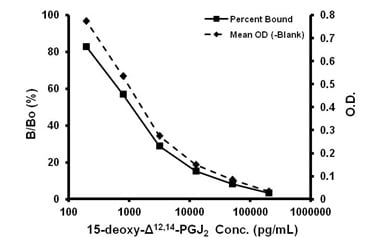15-deoxy-delta12,14-PGJ2 ELISA Kit (ab133031)
Key features and details
- Sensitivity: 36.8 pg/ml
- Range: 195 pg/ml - 200000 pg/ml
- Sample type: Cell culture supernatant, Plasma, Saliva, Urine
- Detection method: Colorimetric
- Assay type: Competitive
- Reacts with: Human, Pig, a wide range of other species
Overview
-
Product name
15-deoxy-delta12,14-PGJ2 ELISA Kit -
Detection method
Colorimetric -
Precision
Intra-assay Sample n Mean SD CV% Low 16 1136pg/ml 5.6% Medium 16 3062pg/ml 5.7% High 16 4394pg/ml 7.4% Inter-assay Sample n Mean SD CV% Low 8 1195pg/ml 15.7% Medium 8 4406pg/ml 13% High 8 7219pg/ml 14.5% -
Sample type
Cell culture supernatant, Saliva, Urine, Plasma -
Assay type
Competitive -
Sensitivity
36.8 pg/ml -
Range
195 pg/ml - 200000 pg/ml -
Recovery
Sample specific recovery Sample type Average % Range Saliva 94.4 % - % Urine 113.9 % - % Plasma 105 % - % Tissue Culture Media 97.4 % - % -
Assay time
5h 0m -
Assay duration
Multiple steps standard assay -
Species reactivity
Reacts with: Human, Pig, a wide range of other species -
Product overview
Abcam’s 15-deoxy-delta12,14-PGJ2in vitro competitive ELISA (Enzyme-Linked Immunosorbent Assay) kit is designed for the accurate quantitative measurement of 15-deoxy-delta12,14-PGJ2 in tissue culture media, saliva, urine, and plasma from a wide range of species.
A goat anti-rabbit IgG antibody has been precoated onto 96-well plates. Standards or test samples are added to the wells, along with an alkaline phosphatase (AP) conjugated-15-deoxy-delta12,14-PGJ2 antigen and a polyclonal rabbit antibody specific to 15-deoxy-delta12,14-PGJ2. After incubation the excess reagents are washed away. pNpp substrate is added and after a short incubation the enzyme reaction is stopped and the yellow color generated is read at 405 nm. The intensity of the yellow coloration is inversely proportional to the amount of 15-deoxy-delta12,14-PGJ2 captured in the plate.
-
Notes
15-deoxy-Δ12,14-PGJ2 is one of the ultimate dehydration products of PGD2. PGD2 is formed from PGH2 which itself is synthesized from arachidonic acid by the enzyme prostaglandin synthase. In the aqueous solution PGD2 forms PGJ2. Albumin or other serum proteins present in the sample will convert PGD2 to the isomeric compound, Δ12-PGJ2. In males about 152 ng of Δ12-PGJ2 is excreted in urine per day, and in women about half this amount is excreted. 15-deoxy-Δ12,14-PGJ2 has been shown as an inducer of adipogenesis and an activator of the γ isoform of the peroxisome proliferation activated receptor (PPARγ).
Cross Reactivity
Compound Cross Reactivity 15-deoxy-Δ12,14-PGJ2 100% PGJ2 49.2% Δ12-PGJ2 5.99% PGD2 4.92% Arachidonic Acid 0.03% PGE2 PGF2α 9α,11β-PGF2α Thromboxane B2 2-Arachidonoylglycerol Anandamide -
Platform
Microplate
Properties
-
Storage instructions
Please refer to protocols. -
Components 1 x 96 tests 15-d-PGJ2 Alkaline Phosphatase Conjugate 1 x 5ml 15-d-PGJ2 Standard 1 x 0.5ml 20X Wash Buffer Concentrate 1 x 27ml Anti-15-d-PGJ2 Antibody 1 x 5ml Assay Buffer 1 x 27ml Goat anti-rabbit IgG Microplate (12 x 8 wells) 1 unit Plate Sealer 2 units pNpp Substrate 1 x 20ml Stop Solution 1 x 5ml -
Research areas
-
Alternative names
- 15-d-PGJ2
- Prostaglandin J2




